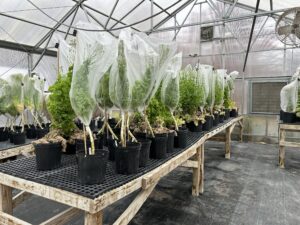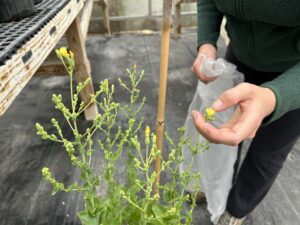More to Explore
Growing Guide: Lettuce

Grow and Save Lettuce Seeds
How to Grow Lettuce
Lettuce is an ideal crop for beginner growers and seed savers alike. Gardeners can choose looseleaf varieties that do not form heads or grow head lettuces that form a head of tightly overlapping leaves.
Time of Planting
Plant in the spring or fall when temperatures are still cool (lettuce bolts in warm temperatures).
Spacing Requirements
Direct sow seeds 1/8 inch deep, 1 inch apart. Thin plants to 6-8 inches apart for Looseleaf, and up to 12 inches apart for head lettuce.
Time to Germination
7-14 days
Special Considerations
Lettuce can be grown in dense plantings to “cut and come again”, or be grown for their heads, in which case they are grown to maturity and harvested once. When growing lettuce for seed, mature plants should be thinned to 12-16 inches in rows 18-30 inches apart.
When lettuce is flowering, warmer temperatures are ideal, and overhead watering during seed production should be limited to improve seed quality.
Common Pests and Diseases
Lettuce is affected by a number of pests and diseases, including aphids, botrytis, and lettuce mosaic virus. Seedlings are also susceptible to damage by blackbirds and sparrows. Remove diseased material from the plants and garden when you notice it, and grow resistant varieties when possible.
When and How to Harvest for Food Consumption
Cut mature lettuce heads at the base, where the stem meets the head. If you’re growing looseleaf or baby lettuce, you can plant seeds closer together and harvest by cutting about 1-2 inches above the soil line, and return in a few weeks to harvest more.
Eating
Lettuce is most commonly eaten fresh in salads or on sandwiches, but can be prepared in a variety of ways. Try making wilted “Crader Family Lettuce” from Mary Katherine Crader Daniels, submitted for the 2022 Seed Savers Exchange Conference!
Storing
You can store lettuce in a plastic bag in the refrigerator for up to 6 days.
How to Save Lettuce Seeds
Life Cycle
Annual
Recommended Isolation Distance
Separate varieties by 10-20 feet.
Recommended Population Sizes

To ensure viable seeds, save seeds from at least 1 plant. When maintaining a variety over many generations, save seeds from 5 to 10 plants. If you’re saving seeds for genetic preservation of a rare variety, save seeds from 20 plants.
Assessing Seed Maturity

When going to seed, lettuce bolts, or develops a branched flowering stalk. Seeds develop on each branch in turn over an extended period of time. When the light gray pappuses emerge from a mature lettuce head—a stage sometimes referred to as feathering—the seeds inside are fully developed and ready to be harvested.
Harvesting
The fruits and seeds of lettuce are fused together so tightly that they are almost indiscernible. Although the fruits are indehiscent and do not break open, they should be collected before they are dispersed by the wind.
A simple seed-gathering technique, useful if seeds are being collected from just a few plants, is to handpick individual seed heads. Once the pappuses have emerged, but before they have fulfilled their seed dispersal function, a gardener can simply take hold of the pappuses to gather the seeds from each mature head.
Each composite flower should produce about 15 to 25 seeds, making this a simple, quick method for gathering enough seeds for home use. More seeds can be collected easily as other heads on the plant mature.
Using another technique, some seed savers bend whole plants or fruiting branches into a bag and gently shake them to dislodge mature seeds. This process is more efficient than hand-picking seeds from separate flowers and can be started when about one-third of the seed heads are mature. It can be repeated every week or two until the desired quantity of seeds has been collected.
Cleaning and Processing
Cleaning methods vary, depending on how the seeds were collected and how much chaff is present. If seeds were gathered by hand-harvesting or shaking plants, there should be relatively little chaff, and cleaning techniques can focus on separating the seeds from the pappuses.
Lightly rubbing the gathered material together between one’s hands or against a screen should detach the seeds from their pappuses without damaging the seeds.
On a larger scale, entire plants can be threshed by rubbing the seed heads, shaking the plants over a large container, or flailing plants on a tarp. After threshing, seeds can be screened and winnowed.
Storage and Viability
When stored under cool, dry conditions, lettuce seeds can be expected to remain viable for six years.
Read more about storing seeds.
Watch this tutorial for more:
How to Save Lettuce Seeds – a short demonstration of how to save lettuce seeds with former Seed Savers Exchange employee Grant Olson